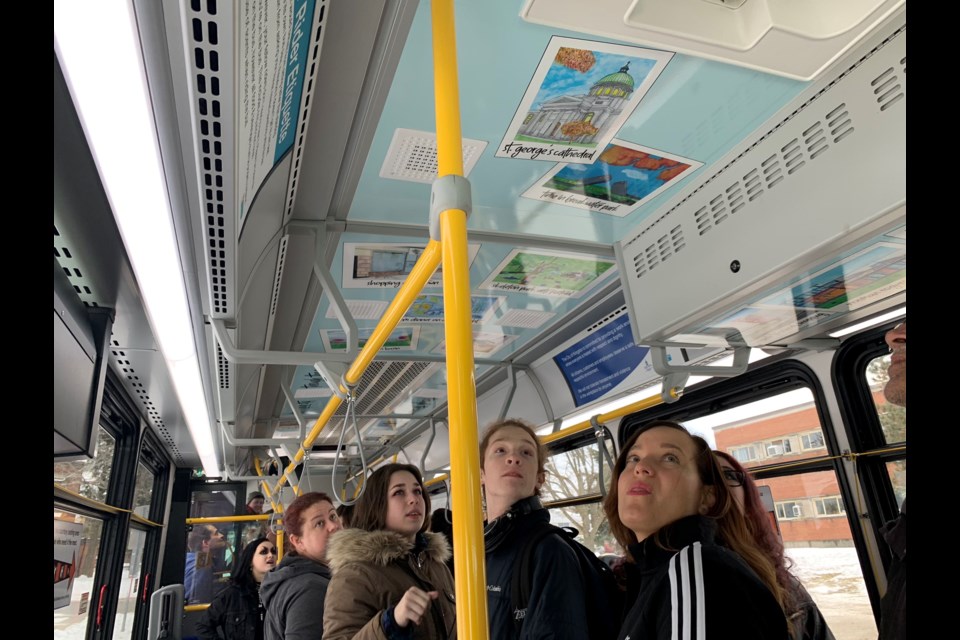Guelph Mayor Cam Guthrie announced last week that he wants free transit for high school students and children under 13.
Three hours northeast, the City of Kingston has had such a program for almost eight years, and it's thriving.
Given the similarities of the two cities (Kingston's population is 136,000) there is a lot Guelph can learn from Kingston's Free Secondary School Transit Program.
“A lot of what they’re doing in Kingston is really what we want in Guelph but it’s really about getting used to using transit and using cars less,” says Steven Petric, chair of the local transit advocacy group Transit Action Alliance of Guelph.
In 2012, Kingston City Council implemented a pilot project that gave each Grade 9 student a fully-subsidized transit pass. One grade was added each subsequent year until all high schoolers had a free pass.
The project is a partnership between the City of Kingston, Kingston Transit and Limestone District School Board.
It costs around $250,000 annually (including lost revenue), with the city paying roughly $75,000 of that. The school boards and provincial funding pays the rest.
In that first year, students accounted for approximately 28,000 rides. That number now sits at 600,000 rides annually and accounts for 10 per cent of Kingston Transit’s total ridership.
It all began the same way a Guelph program might have: with a mayor's want.
In 2012, Kingston mayor Mark Gerretsen had an idea of providing free transit to young people. The conversation then began with the mayor, transit staff, and a representative from the school board on how they can make that happen.
“It started with Grade 9 students, then each year we added a grade to the point where all high school students were eligible and now it’s an ongoing program,” says Jeremy DaCosta, Director of Transit at the City of Kingston.
DaCosta says in the first year of the program, they ran into a problem when they learned not many Grade 9 students knew how to use transit.
“Now when students come into high school and Grade 9, transit staff working with the school board go to each school and every Grade 9 student receives a pass and we do an orientation with the students,” says DaCosta.
That includes orientation that teaches students about how to use transit, etiquette on the bus, maps around the city and more to make them comfortable with the process of using public transportation.
“The pass that the students are issued allows them to ride transit anytime they want, any day they want, any time of day they want, any day of the week they want,” says DaCosta.
DaCosta says the program is focused on enabling the youth to use transit which gives them their own independence and is also beneficial for the environment.
“It gives students the freedom to participate in the community, it gives them the opportunity to participate in activities that they otherwise might not have had the opportunity to participate in,” says DaCosta.
He says when students are comfortable with transit early in life, there is a higher likelihood of them using it in the future as they become adults.
“And so by immersing them in it all at once it also is kind of a social equalizer. I guess they all get it together. They're all 14, they can't drive yet. So it's proved to be very successful,” says Dan Hendry, sustainable initiatives coordinator at the Limestone District School Board who worked together with DaCosta to pioneer the program.
Hendry also conducts the orientations for Grade 9 students at the beginning of the school year. He also delivered a TED Talk that discusses the potential of transforming public transportation by training the youth.
“So because we catch them young and because we get them all together and because we normalize it and show them the different values of health, social, economic, and environmental, you can see the appreciation, and I think by the usage, which is them using in droves.”
Hendry says the program opened up the community in many ways with families connecting with each other, students hopping on the bus together and participating in activities outside of school.
While the city didn't change any bus routes, it did introduce express services and increased frequency on existing major routes, providing direct and reliable service near all of the high schools and all main neighbourhoods in the city.
DaCosta says convenience has to be a key for all transit riders in order to want to take the bus.
“The program was, let’s get young people excited about taking transit,” says DaCosta.
The group looked at data to analyze when high school students are mostly using the bus and found that 40 per cent of the 600,000 trips were not related to school at all.
DaCosta says that data shows that students were being enabled with a mobility option that they otherwise might not have unless they were relying on their friends and family.
“We have estimated that the cost to provide high school students with free transit compared to collecting fares from students who would likely pay to ride estimated about $250,000 per year,” says DaCosta.
That's paid for by the city's school boards ($60,000), provincial funding sources ($100,000-$125,000) and the rest by the City of Kingston.
At the annual State of the City address, Guthrie says a program with free transit for all high school students and children under 13 will be a game-changer for families and students and will introduce a motion shortly to go to city council.
Petric says TAAG will be holding a discussion about the idea of free transit for youth at an upcoming information gathering at Planet Bean in Downtown Guelph on Feb. 22 starting at noon. The public is invited.
